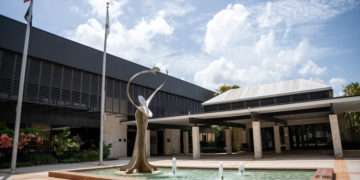Charlotte County’s workforce is short of employees in both the public and private sectors, according to data from CareerSource Southwest Florida.
To address the ongoing problem, the nonprofit partnered with Charlotte County Human Resources to host a job fair today at the Charlotte Harbor Event and Conference Center in Punta Gorda.
The job fair provided information on full- and part-time, seasonal and temporary positions, including internships in public works, utilities, law enforcement, firefighting and emergency medical services, schools and parks and recreation.
It is just one of the latest events hosted in the county to address the ongoing workforce shortfall CareerSource Communications Director Amy Hanna-Eckenrode said is caused by several factors.
“Not only are we dealing with the recovery from Hurricane Ian, but many other factors, which go back to the days of [COVID-19],” she said.
Demographics also play a role. According to the 2020 U.S. Census, 40.6% of Charlotte County’s population is 65 years and older, and the county’s median age is 59.7 years.

Amy Hanna-Eckenrode
Baby boomers, meaning those born between 1946 and 1964, numbered 76.4 million in the country, census numbers indicate. Many were still working in either their original or second careers when the pandemic arrived, leading them to begin retiring and leaving the workforce, Hanna-Eckenrode said.
“Now, there simply are not as many people in the workforce as there were a few years ago,” she said. “… Southwest Florida has so much going for it, including an influx of new residents every day—1,300 statewide daily—and the health influx of new businesses relocating and locating to Southwest Florida.”
With that, however, comes a strong demand for housing and other services.
“The economy is making it exceedingly difficult for people to make ends meet right now,” Hanna-Eckenrode said. “The rising cost and shortage of housing options, the price of gas, groceries and child care are taxing our existing workforce.”
While construction in Southwest Florida is booming and new housing developments and apartments are in various stages in Charlotte County, the question is whether a younger workforce can afford the price of homes and rents.
Various nonprofit groups and Charlotte County agencies have been discussing the affordable housing disparity for a number of years.
By 2025, the county must add 10,918 housing units to keep pace with projected demand, according to a Charlotte County Board of County Commissioners report. Of those, 5,553 units should be affordable for those making 80% of the Area Median Income and below.
Affordable housing is defined as consuming no more than 30% of a household’s income, the report states.
However, 40% of households in Charlotte County are considered financially unstable, where the cost of housing and cost of living versus wages often don’t line up.
Some businesses have begun paying higher wages.
 Teacher salaries in the region have increased after districts experienced a teacher shortage. Charlotte County Public Schools raised salaries to match what Sarasota County was paying after Charlotte teachers were leaving to work over the county line in North Port.
Teacher salaries in the region have increased after districts experienced a teacher shortage. Charlotte County Public Schools raised salaries to match what Sarasota County was paying after Charlotte teachers were leaving to work over the county line in North Port.
When Sunseeker Resort in Charlotte Harbor began its hiring spree, it promised a living wage and $100,000 bonus after 10 years of employment, as well as free flights on Allegiant Air and full benefits. The resort set to open in the fourth quarter of this year is still having difficulty filling its 1,200 positions and has been hosting its own job fairs.
“Aside from the recent $1 an hour (minimum) wage increase and most businesses already offering higher wages, CareerSource SWFL has been working closely with local businesses to create new ways to address the rapidly changing workforce needs, such as through work experience and on-the-job training programs,” Hanna-Eckenrode said.
Once an employer finds ideal candidates, there are other challenges.
“We’re also looking at a whole new generation that has very different wants and needs from the workplace,” she said. “Businesses are doing their best to accommodate new requests, such as remote work, flex-time requests, etc., something they didn’t face a few years ago.
“The whole face of our workforce is changing and what are in-demand occupations today are quite different than what they were even a few years ago.”
Some workers find their careers are becoming obsolete. To address this need, CareerSource SWFL is working with local educational institutions to provide funding to qualified individuals for training.
Hanna-Eckenrode said would-be workers should pay attention to the rise of credentialing programs being created to help train and fill workforce needs in various trades, such as construction, plumbing, electrical and health care.





